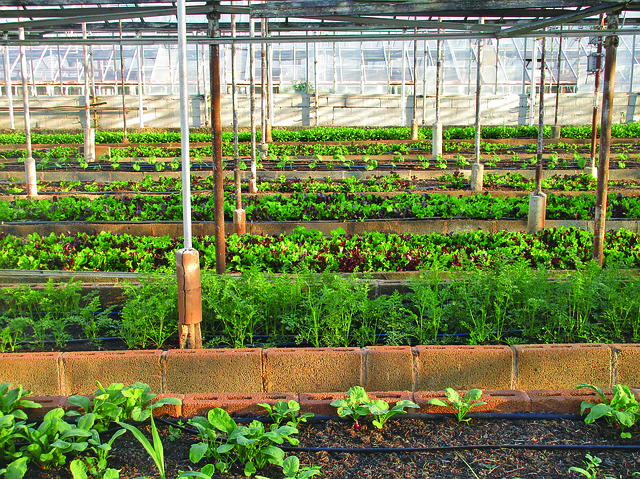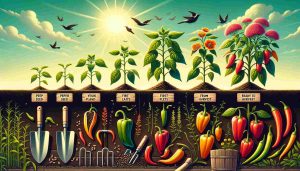There’s something truly magical about getting your hands in the soil, watching your plants grow, and eventually reaping the rewards of your hard work. But beyond the joy and satisfaction, many of us wonder if gardening can actually save us some green, both in terms of money and the environment. Well, as an avid gardener myself, I’m here to share my experiences and give you some insight into the age-old question: Is gardening cheaper than buying?
Yes, gardening can be cheaper than buying. By growing your own food and plants, you can save on grocery expenses, enjoy seasonal produce, and embrace a sustainable and cost-effective lifestyle.
Before I dive into the details, I want to take a moment to tell you how gardening has become a cherished part of my life. It started with a small window box and a handful of herb seeds, and now my backyard has transformed into a flourishing garden oasis. The excitement of growing my own food and nurturing beautiful plants has not only brought me closer to nature but has also opened my eyes to the financial benefits that come with it.
Let’s get to it!
The Joy of Growing Your Own
There’s an undeniable sense of joy and fulfillment that comes with growing your own plants, whether it’s vibrant flowers or delicious vegetables. As I’ve discovered on my gardening journey, this joy goes beyond the cost considerations and truly enriches our lives in countless ways. Let’s explore the magical aspects of growing your own garden:
- Connection with Nature: Gardening allows us to reconnect with the natural world and witness the beauty of the growth process firsthand. From planting a tiny seed to witnessing it sprout, bloom, and eventually bear fruit, the entire cycle is a wondrous experience that fosters a deep appreciation for the miracles of nature.
- Sense of Accomplishment: There’s a unique sense of accomplishment and pride that comes with successfully growing and nurturing plants. Each healthy plant represents our dedication, patience, and hard work. Trust me, the feeling you get when you bite into a tomato you grew yourself is unbeatable!
- Educational Value: Gardening provides a fantastic opportunity for both children and adults to learn about plant life cycles, ecosystems, and the importance of sustainability. It’s a hands-on classroom where knowledge and curiosity flourish, fostering a lifelong love for nature and the environment.
- Stress Relief and Mindfulness: Spending time in the garden can be incredibly therapeutic. It offers a chance to unwind, relieve stress, and escape the hustle and bustle of everyday life. The simple act of tending to plants and immersing ourselves in their growth process brings a sense of peace and mindfulness.
- Quality Time Outdoors: In a world dominated by screens and technology, gardening offers a precious chance to disconnect and spend quality time outdoors. Whether it’s by yourself or with loved ones, gardening creates opportunities for bonding, shared experiences, and making lasting memories.
The joy of growing your own garden goes beyond financial considerations. It’s about nurturing life, cultivating a deeper connection with nature, and reaping the intangible rewards that money can’t buy.
Comparing Initial Costs
When it comes to gardening, one of the first factors we consider is the initial investment required. While it’s true that there are some costs involved in getting started, the good news is that gardening can be tailored to fit various budgets. Let’s take a closer look at the initial costs and explore some budget-friendly options:
- Tools and Equipment: To get started, you’ll need a basic set of gardening tools, such as a trowel, pruners, rake, and watering can. These tools are generally affordable and can be found at garden centers, hardware stores, or even second-hand markets. Consider purchasing quality tools that will last longer and save you money in the long run.
- Seeds and Plants: The cost of seeds and plants can vary depending on what you choose to grow. Seeds are generally more budget-friendly, and you can often find a wide variety at reasonable prices. Alternatively, purchasing young plants from nurseries or local farmers’ markets can be a convenient option if you prefer to skip the germination stage.
- Soil and Amendments: Good soil is the foundation of a successful garden, and investing in quality soil is essential. You may need to purchase bags of organic soil or compost to enrich your garden bed. However, if you have access to a compost bin, you can create your own nutrient-rich compost, reducing the need for additional purchases.
- Raised Beds or Containers: If you have limited space or poor soil quality, you may opt for raised beds or containers. While there is an upfront cost associated with building or purchasing these, they offer long-term benefits such as better soil control, reduced water usage, and easier maintenance.
- Protective Measures: Depending on your region, you might need to consider protective measures against pests, such as fencing, netting, or organic pest control methods. These can be budgeted for as necessary and are generally cost-effective compared to the potential losses from pests.
It’s important to note that while there are some initial costs, many of these expenses are one-time or occasional investments. Once you have your basic gardening toolkit and a healthy soil foundation, you can reuse seeds, propagate plants, and even save money by collecting and storing seeds from your own harvest.
Gardening is a journey, and it’s perfectly okay to start small and gradually expand your garden as your budget allows. With careful planning and resourcefulness, you can keep the initial costs within your means and enjoy the long-term benefits of a bountiful garden.
The Economics of Harvesting Your Own Food
One of the significant advantages of gardening is the potential for saving money on your grocery bill by growing your own food. Let’s dive into the economics of harvesting your own food and explore how it can positively impact your wallet:
- Cost of Store-Bought Produce: It’s no secret that the cost of fresh produce at grocery stores has been steadily rising. By growing your own fruits, vegetables, and herbs, you can significantly reduce your reliance on store-bought produce and save money in the process. Think about the savings you’ll enjoy by not having to purchase expensive organic produce or specialty items that might not be easily available.
- Seasonal Eating: When you grow your own food, you have the power to eat seasonally, which can be more cost-effective. Focusing on crops that thrive during specific seasons allows you to capitalize on favorable growing conditions and abundance. This means less reliance on expensive out-of-season produce that often needs to be transported long distances.
- High-Yield Crops: Certain crops, like tomatoes, zucchinis, and herbs, can produce an abundance of food with minimal effort. These high-yield crops offer a fantastic return on your investment, as you’ll be able to enjoy an ample supply of fresh produce without breaking the bank.
- Reduced Waste: Have you ever bought a bunch of herbs or a bag of lettuce only to use a fraction of it before it spoils? When you grow your own food, you can harvest what you need when you need it, reducing food waste and saving money. Plus, any excess harvest can be preserved through canning, freezing, or drying, extending its usability throughout the year.
- Organic and Chemical-Free: By growing your own food, you have control over the cultivation methods. You can choose to grow your crops organically, avoiding expensive organic produce prices at the grocery store. Additionally, you can skip the use of chemical pesticides and fertilizers, ensuring a healthier and more cost-effective alternative.
It’s important to acknowledge that gardening does require time, effort, and a certain level of commitment. However, the financial benefits and the satisfaction of eating food you’ve grown yourself make it a worthwhile endeavor. Not only can you save money, but you’ll also gain the peace of mind of knowing exactly how your food was grown.
Landscaping and Ornamental Plants
When discussing the cost-effectiveness of gardening, it’s essential to consider not only the edible plants but also the expenses associated with landscaping and ornamental plants. Let’s take a closer look at how the costs of buying and maintaining ornamental plants compare to creating your own garden:
- Purchasing Ornamental Plants: Buying fully grown ornamental plants, flowers, and shrubs from nurseries or garden centers can be quite expensive, especially for larger and more mature specimens. The cost can add up quickly, especially if you have a significant area to fill or desire a variety of plants for a diverse garden.
- Maintenance and Upkeep: Ornamental plants often require regular maintenance, such as pruning, watering, fertilizing, and pest control. Depending on the plants you choose, this can involve ongoing costs for specialized fertilizers, pesticides, and tools. Additionally, some plants may need protection from harsh weather conditions, which may require extra investments like covers or shelters.
- Propagation and Division: On the other hand, gardening allows you to propagate and divide plants, which can significantly reduce costs. Many ornamental plants can be easily multiplied through techniques such as stem cuttings, division, or seed propagation. By growing plants from seeds or taking cuttings from existing plants, you can expand your garden without spending a fortune.
- Perennials and Self-Sowing Plants: Incorporating perennials and self-sowing plants into your garden can be a cost-effective strategy. Perennials come back year after year, reducing the need to purchase new plants annually. Self-sowing plants, such as poppies or cosmos, produce seeds that naturally scatter and germinate, creating new plants without any effort or cost on your part.
- DIY Garden Structures: Creating garden structures, such as trellises, arbors, or raised beds, can be more cost-effective when you build them yourself. By utilizing materials like reclaimed wood, recycled items, or even repurposed furniture, you can add charm and functionality to your garden without breaking the bank.
While landscaping and ornamental plants can add beauty and aesthetics to your outdoor space, it’s important to strike a balance between cost and enjoyment. Consider incorporating a mix of ornamental and edible plants in your garden to maximize both visual appeal and practicality.
Gardening on a Budget
Gardening doesn’t have to be an expensive endeavor. With a bit of creativity and resourcefulness, you can enjoy the benefits of gardening without breaking the bank. Here are 7 practical tips for gardening on a budget:
- Start Small: If you’re new to gardening or have a limited budget, start with a small garden plot or even containers. This allows you to focus your resources on a specific area and manage it effectively. As your confidence and budget grow, you can expand your garden gradually.
- Seed Swapping and Sharing: Connect with fellow gardeners in your community and participate in seed swapping events or plant sharing groups. It’s a fantastic way to acquire new plant varieties without spending money. Additionally, consider saving seeds from your own harvest to use in future seasons.
- Opt for Open-Pollinated Seeds: Open-pollinated seeds, as opposed to hybrid or genetically modified ones, are more budget-friendly and can be saved for future plantings. They produce plants with seeds that can be collected and replanted, ensuring a continuous supply of plants without the need for frequent seed purchases.
- Utilize Compost and Mulch: Instead of purchasing expensive fertilizers and soil amendments, create your own compost. Composting not only reduces waste but also provides nutrient-rich soil for your garden. Additionally, use organic mulch, such as leaves or grass clippings, to retain moisture, suppress weeds, and improve soil health.
- DIY Garden Tools and Structures: Embrace your inner handyman or woman by creating your own garden tools and structures. For example, you can repurpose old wooden pallets into raised beds or construct trellises using bamboo stakes and twine. DIY projects not only save money but also add a personalized touch to your garden.
- Seek Free or Discounted Resources: Keep an eye out for free or discounted resources for your garden. Many municipalities offer free compost or wood chips, while gardening centers may have end-of-season sales or discounted plants. Don’t forget to check online marketplaces or community groups where gardeners often share or give away plants and gardening supplies.
- Water-Wise Gardening: Be mindful of water usage and adopt water-wise gardening practices. Install a rain barrel to collect rainwater for your plants and consider drought-tolerant plant varieties that require less water. Efficient watering practices not only save money on your water bill but also contribute to environmental conservation.
Gardening on a budget is about finding creative solutions and making the most of what you have.
Seasonal Eating and Food Preservation
When it comes to gardening, one of the significant advantages is the ability to embrace seasonal eating. Not only does it provide health benefits, but it can also be a cost-effective approach. Let’s explore how seasonal eating and food preservation can help you save money and enjoy your garden’s harvest throughout the year.
- Cost Savings: Seasonal produce tends to be more abundant and readily available, resulting in lower prices. By aligning your garden’s harvest with the natural seasons, you can enjoy a bountiful supply of fresh fruits and vegetables without paying a premium for out-of-season items. This translates to significant cost savings over time.
- Reduced Transportation Costs: Out-of-season produce often requires long-distance transportation to reach your local grocery store, which contributes to increased costs. By growing your own seasonal produce, you eliminate the need for transportation and reduce your carbon footprint in the process.
- Food Preservation: When your garden yields a surplus of fruits and vegetables during peak seasons, preserving the excess harvest is an excellent way to extend its usability. Methods such as canning, freezing, and drying allow you to enjoy your homegrown produce throughout the year, saving you from purchasing expensive preserved items from the store.
- Batch Cooking and Meal Planning: As your garden’s harvest comes in abundance, consider batch cooking and meal planning. By preparing larger quantities of meals and freezing them in portioned containers, you not only save money on groceries but also reduce food waste. Plan your meals based on the seasonal ingredients available in your garden to maximize cost-effectiveness.
- Herb Drying and Freezing: Herbs are another garden treasure that can be preserved easily. Dry herbs by hanging them in a well-ventilated area or freeze them in ice cube trays with a bit of water or olive oil. These preserved herbs will add flavor and aroma to your dishes long after the growing season has passed.
- Homemade Preserves and Sauces: Turn your garden’s fruits into homemade preserves, jams, and sauces. From tangy tomato sauce to sweet berry jam, these homemade delights not only save money but also offer a taste of summer in the colder months. Get creative with recipes and experiment with different flavor combinations.
Health and Environmental Benefits
Gardening goes beyond cost considerations. It offers a multitude of health benefits for both individuals and the environment. Let’s explore how gardening positively impacts our well-being and contributes to a greener world:
- Physical Health: Gardening is a fantastic way to stay physically active. Whether it’s digging, planting, weeding, or watering, these activities engage your muscles and provide a low-impact form of exercise. Regular gardening can improve strength, flexibility, and cardiovascular health.
- Access to Fresh, Nutritious Food: Growing your own fruits, vegetables, and herbs ensures access to fresh, nutrient-rich food. By consuming the produce from your garden, you can enjoy the health benefits of a varied and well-balanced diet. This control over what goes into your food promotes healthier eating habits.
- Mental Well-being: Spending time in nature and engaging in gardening activities has a positive impact on mental well-being. It reduces stress, anxiety, and depression while promoting relaxation and a sense of calm. Gardening allows us to disconnect from technology, reconnect with nature, and find solace in the therapeutic aspects of nurturing plants.
- Environmental Conservation: Gardening plays a crucial role in environmental conservation. By growing your own food, you reduce the demand for commercially grown produce, which often requires extensive pesticide use and contributes to deforestation. Additionally, maintaining a garden promotes biodiversity, providing habitat for beneficial insects, birds, and other wildlife.
- Reduction of Food Miles: Food miles refer to the distance that food travels from the farm to your plate. By growing your own food, you reduce the carbon footprint associated with transportation and packaging. Eating locally produced food contributes to a more sustainable food system and reduces greenhouse gas emissions.
- Water Conservation: Conscious gardening practices such as using mulch, water-wise irrigation methods, and collecting rainwater in barrels help conserve water. By efficiently managing water usage, you contribute to water conservation efforts and promote sustainability.
- Teaching Sustainability: Gardening provides an excellent opportunity to teach future generations about sustainability, self-sufficiency, and the importance of protecting our environment. Involving children in gardening activities fosters a connection with nature, instills a sense of responsibility, and promotes a sustainable mindset.
The holistic benefits of gardening extend far beyond financial savings. It’s a powerful tool for improving physical health, nurturing mental well-being, and fostering environmental stewardship.
Gardening as a Hobby and Lifestyle
Gardening is more than just a cost-effective activity—it’s a fulfilling hobby and a way of life. It has the power to enrich our lives in countless ways and become an integral part of who we are. Let’s delve into why gardening is not only an economical choice but also a rewarding and transformative experience.
- Stress Relief and Relaxation: Gardening provides a sanctuary from the stresses of daily life. The act of tending to plants, feeling the soil in your hands, and being immersed in nature brings a sense of peace and tranquility. It’s a therapeutic escape that allows you to unwind, find solace, and recharge your energy.
- Creativity and Self-Expression: Gardening is an artistic outlet that allows you to express your creativity. You have the freedom to design your garden, choose plant combinations, and experiment with different colors, textures, and arrangements. It’s an opportunity to create a personalized space that reflects your unique style and vision.
- Continuous Learning: Gardening is a lifelong journey of learning and growth. There’s always something new to discover, whether it’s trying different plant varieties, exploring new techniques, or gaining knowledge about the natural world. The learning process keeps your mind engaged and nurtures a sense of curiosity and wonder.
- Connection with Seasons and Nature: Gardening allows us to reconnect with the cycles of the seasons and the rhythms of nature. From the awakening of spring to the harvest of fall, gardening keeps us attuned to the natural world. It fosters a deeper appreciation for the beauty, diversity, and interconnectedness of all living things.
- Nurturing Relationships: Gardening can be a social activity that brings people together. Whether it’s working side by side with family members, participating in community gardening projects, or joining gardening clubs, it creates opportunities for bonding, sharing knowledge, and cultivating meaningful connections with others who share your passion.
- Sustainability and Self-Sufficiency: As you embrace gardening as a lifestyle, you become more self-sufficient and sustainable. Growing your own food, preserving the harvest, and minimizing waste align with the principles of environmental stewardship. You’ll gain a sense of empowerment, knowing that you can provide for yourself and contribute to a more sustainable future.
Conclusion
In conclusion, the answer to the question “Is gardening cheaper than buying?” is a resounding yes. While gardening does require initial investment, the long-term savings and benefits are worth every penny. By growing your own food and plants, you can reduce your grocery expenses, enjoy fresh and nutritious produce, and embrace a sustainable and cost-effective lifestyle.
Gardening empowers you to take control of your food supply, eliminate reliance on expensive store-bought produce, and even experiment with unique plant varieties. It provides a rewarding and transformative experience that extends beyond financial considerations. The joy of nurturing life, the therapeutic benefits, and the sense of accomplishment make gardening a truly fulfilling endeavor.
Moreover, gardening promotes self-sufficiency, encourages sustainable practices, and fosters a deeper connection with nature. It allows you to reduce your carbon footprint, engage in seasonal eating, and contribute to a greener world.
So, whether you have a sprawling garden or a small balcony, embrace the thrifty and rewarding world of gardening. Enjoy the satisfaction of growing your own food, reaping the bountiful rewards, and nurturing a lifestyle that is not only cost-effective but also nourishes your body, mind, and soul.










